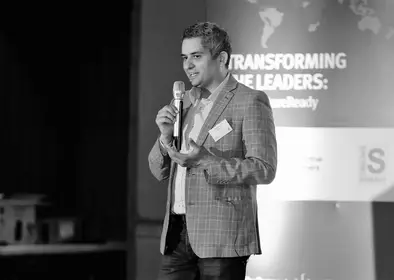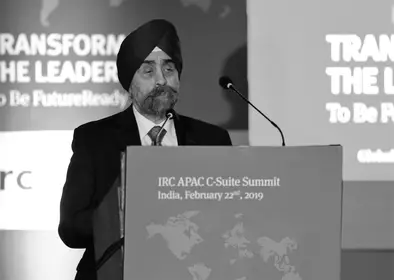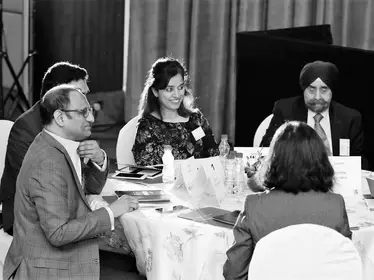Executive Summary
- Reinforce your vision: Seek buy-in communicating your company’s vision and reiterate values continually with staff and customers as a mantra and by embodying those values.
- Create the culture to attract the talent: Find the talent you need by creating an attractive corporate culture that candidates with the right skill set aspire to.
- Surround yourself with knowledge: Acknowledge you don’t know what you don’t know and surround yourself with experts who have the specific expertise you lack.
- Cultivate an entrepreneurial mindset: Encourage innovation and entrepreneurial risk-taking by rewarding new ideas and embracing failure as a valuable learning opportunity.
- Leverage technology: Build digital platforms to improve communication, make internal processes more efficient and to reinvent and improve the customer experience.
- Embrace growing complexity: The complexities of the future require innovative solutions and agile leadership to anticipate challenges and exploit new opportunities.
The digital space has revolutionised how we communicate, and future-ready leaders leverage this to make internal and external communications fluid and transparent by connecting directly with end customers and by promoting knowledge sharing.
There’s no one solution to effective future-ready leadership, but all the best leaders have the ability to bring the brightest minds to an organisation and let the best talent flourish by creating an environment that accepts failure and promotes risk-taking as part of the innovation process.
Prashant Tandon, Founder and CEO of 1mg Technologies, at the Kestria APAC Summit 2019As organisations face competition from disruptive forces and are challenged by growing complexity related to rapid technological change, they should adapt accordingly while maintaining their focus on core activities and outsource what can be provided more effectively externally. Innovation should start with a simple thought process aimed at “figuring out a better way to do something”, in the words of Prashant Tandon, Founder and CEO of 1mg Technologies. Leadership starts with a dream and the effective communication and transfer of that dream. Once others believe in a dream and think they can get something out of it, they are compelled to participate and work towards its realisation.
Transform Holistically
Future-ready leaders are prepared to quickly reinvent their organisations by learning how to think differently with the cognitive transformation that gets at how the company needs to operate to optimise its virtual presence and maximise opportunities in the digital space. Retailers, for example, need to develop online stores and transform flagship brick and mortar outlets to provide consumers with a unique and immersive experience.
Being future-ready also requires leaders to undergo an emotional transformation that allows them to react differently, to listen more, ask more and be ready to respond with innovative solutions. By engaging employees in informal forums, facilitative leaders encourage learning for themselves and their reports, helping build develop skills for the future. Facilitative leaders know how to extract the best thinking from the people in the room and ensure all the voices are heard to extract the collective wisdom from a group. A behavioural transformation is also necessary in order to establish a different way of interacting with employees and consumers that reinforces a company’s values and culture.
Another way organisations can ensure they are future-ready is by investing in diversity, not just by hiring employees of different backgrounds but by seeking candidates from multiple industries. A diverse workforce will ensure preparedness even when decisions need to be made based on incomplete information about what the future will present. Broad technical know-how informed by a wide range of sectors and a diverse workforce can help ensure both preparedness and resilience. Investing in diversity goes beyond hiring, however, and requires creating opportunities for employees from different geographies, backgrounds and disciplines to come together for immersive learning and the exchange of ideas. This can help predict changes that are likely to impact a company and help channel resources to the right kind of innovation while broadening the analysis of the competitive landscape.
Harness Technology
The global auto industry is a prime example of a sector facing disruption from new competitors and a fundamentally altered landscape. Conventional notions of mobility have been turned upside down, and unconventional competitors, including micro mobility start-ups and companies like Tesla’s fully dedicated to electrified transport, have spurred a race to develop new technologies. Today’s vehicle manufacturers are transforming themselves by integrating new designs, autonomous technologies, display solutions, cutting edge software coupled with new sensors and electric drive motors. These changes are being driven by external forces like new environmental regulations and evolving demands of the market. Today’s customers want a seamless experience that marries environmental sustainability and the technology and comfort they’ve become accustomed to.
As more and more businesses are digitised, data points are exploding, inundating companies with the information they may not know how to utilise effectively. Technology is a key enabler to manage big data and achieve predictable solutions. Organisations have the opportunity to understand their market segments with an unprecedented degree of granularity and to interact with their customers to obtain crucial information to guide resource allocation, refine processes and improve the overall customer experience. Technology can also play a critical role in how workforces are reskilled, retained and motivated.
The world is becoming smaller, and boundaries are dissolving to match the virtual, digital space where there are no borders. Technology allows organisations that didn’t historically connect directly with their end users to do so. It’s not just about technology. However, it’s also about how to manage old processes and adapt to what the world needs. This often requires marshalling the resources you have in the team to identify the best way to solve problems here and now.
Know Your Limits
Future-ready leaders recognise they can’t be expected to know everything. Future-ready leaders accept a new paradigm by embracing the limits of their own knowledge and by resolving to be life-long learners, adept at surrounding themselves with smart people who have the expertise they need to steer organisational transformation in the right direction. The best-prepared leaders have a team around them that makes up for what they don’t know.
Kestria APAC Regional Leader Gurdeep S. HoraLeaders need to be paranoid, to a certain degree, to survive. Success breeds complacency and complacency breeds failure; worrying about what may be coming down the pike just out of sight can avoid the kind of overconfidence that causes organisations to be blindsided by disruptive competitors. Leaders need to be aware and well-informed. It’s not only about jobs becoming redundant but the functions those employees perform becoming obsolete. Business leaders need more time than they once did to indulge curiosity, experiment and understand the evolving needs of their customers.
As the forces of technological change and market disruption accelerate, the planning horizon for an organisation has shortened, and “long-term” in this context has shrunk to three-to-four years. To stay ahead, leaders need to stay agile, which isn’t possible if they are afraid of technology. Visionary leaders anticipate challenges and begin planning for them now.
As the business world becomes more open and transparent, customers are driving changes as companies adapt to meet their expectations. Customers expect companies to respond quickly with solutions. Organisations like Siemens have flattened their corporate structures to improve responsiveness and become more customer-centric. The appointment of young chief digital officers is another trend that can ensure organisations are tuned in to the youngest team members and consumers.
Reward Failure
Many cutting-edge companies that rely on entrepreneurial endeavour are a rewarding failure as a way to encourage innovation. If an employee fails and changes in the next step, they are helping transform the organisation. When they encounter a problem, they can raise it with colleagues to solicit a rapid response and come up with a solution collectively. This is one-way organisations can prepare themselves to take risks and derive value from those risks at a minimal cost. Transformative leadership doesn’t fear change but rather sees new opportunities, allowing failure, being patient and having fun with it under the premise that we all fail and it’s better to have a good laugh about it, learn from it and ensure it doesn’t happen again.
Facilitate Mentoring
Schneider is one of many organisations to introduce reverse mentoring to keep senior leaders at the cutting edge of digital transformation. The company pairs executives with employees under the age of 30 to ensure they are well-informed about the latest technology, consumer trends and how the market is changing. Tata Motors has a similar program in place where the executive committee meets with employees of Generation Z on each plant visit to understand what motivates this segment of the workforce and their age group peers in the market.
One of the round-tables at the Kestria Summit with representatives of Cummins, Philips, RPG GroupAs organizations transform themselves to meet the challenges and market demands of the future, many are raising fundamental questions about how things have been done in the past rather than approaching change with small, incremental steps, challenging basic assumptions like the value of performance assessments, whether returns can be processed in less than five days, or whether there should be a fee assessed for product exchanges. Many companies are placing more emphasis on seeking candidates full of passion and pride over those that may have more years of experience in order to attract bright, young people who will put new business strategies into action effectively without resisting new ideas.
Prepare for New Challenges
Automation, machine learning and artificial intelligence will become increasingly important in many industries and will challenge conventional functions. Humans will never be obsolete despite these advances, but these technological changes will require labour to be repurposed. The need to boost productivity at a greater pace than operational expenditure is a classic challenge that won’t be solved by automation alone and will require skilled leadership and human innovation.
Future-ready leaders start with a dream, present a powerful idea that is novel or out-of-the-box, or a problem that was all around us but that somebody saw and decided was worth making an effort to solve, notwithstanding the risk of failure. Once that dream, or idea, is defined and the angle of attack has been effectively transferred to a team ready to work towards a solution, there are known unknowns and unknown unknowns that must be considered by the leader to ensure the proposed solution is future-proof.
Innovation starts with a simple thought process and is prone to failure. Future-ready leaders and organisations build inevitable failure into their DNA and their growth process to ultimately learn from mistakes and find new ways of solving problems. It’s like a relationship you are committed to; all have pitfalls, but committed partners accept the setbacks and build stronger partnerships by learning from failure.
Digital transformation represents a great tool, a great enabler of new communication channels that bring collaborators closer and facilitate communication between leaders and their team members and between organisations and the customers they serve. Technology will help find solutions, but it has its limitations. No technology can replicate compassion and intuition, key soft skills that must be harnessed by effective future-ready leaders. The power of the human mind is still paramount and tomorrow’s leaders accept the responsibility of leveraging this power to ensure they and the organisations they lead are well equipped for resilient growth.



